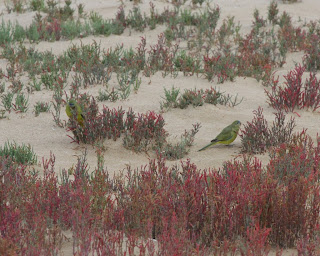
Not really a sky photo, but I love the way the sun's rays come through the trees.
 Our guide spotted some Barred Owls
Our guide spotted some Barred Owls
 My first Skimmer.
My first Skimmer.
 I had heard about the Scissor-tailed Flycatcher, and it certainly lived up to it's reputation - beautiful!
I had heard about the Scissor-tailed Flycatcher, and it certainly lived up to it's reputation - beautiful!
 Red!! (for Kelly!)
Red!! (for Kelly!)
 The Green Jay was also stunning
The Green Jay was also stunning
 Golden-fronted Woodpecker
Golden-fronted Woodpecker
 Plain Chachalaca
Plain Chachalaca
 My first Hummingbirds - Black-chinned
My first Hummingbirds - Black-chinned
 Seeing around 12 Million Mexican Free-tailed Bats emerging from their cave at dusk was the highlight of the trip for me.
Seeing around 12 Million Mexican Free-tailed Bats emerging from their cave at dusk was the highlight of the trip for me.
 Rufous Hummingbird
Rufous Hummingbird
 And searched for and eventually saw the striking Golden-cheeked Warbler.
And searched for and eventually saw the striking Golden-cheeked Warbler.
 Ash-throated Flycatcher
Ash-throated Flycatcher
 Harris' Hawk
Harris' Hawk


 The workshop was hosted by the Department for Environment and Heritage, and concerned the critically endangered Orange-bellied Parrot. This parrot is on the verge of extinction with only 50 birds left in the wild (all of which breed at one site in Tasmania)and approximately 200 in captivity. The reintroduction of captive birds at a second site in Tasmania has been suspended as it was not successful. You can read more about the OBP here.
The workshop was held to help people identify OBP from the other three common similar species in the area, Elegant Parrot, Rock Parrot and Blue-winged Parrot in preparation for the first of three winter surveys.
After the workshop, we all went to Hindmarsh Island to look for parrots. OBP has been recorded here in the past, but we were not expecting to see any and were not disappointed. Hindmarsh Island is at the northern end of the Coorong National Park, and the area we visited was an area of saltmarsh and Samphire.
The workshop was hosted by the Department for Environment and Heritage, and concerned the critically endangered Orange-bellied Parrot. This parrot is on the verge of extinction with only 50 birds left in the wild (all of which breed at one site in Tasmania)and approximately 200 in captivity. The reintroduction of captive birds at a second site in Tasmania has been suspended as it was not successful. You can read more about the OBP here.
The workshop was held to help people identify OBP from the other three common similar species in the area, Elegant Parrot, Rock Parrot and Blue-winged Parrot in preparation for the first of three winter surveys.
After the workshop, we all went to Hindmarsh Island to look for parrots. OBP has been recorded here in the past, but we were not expecting to see any and were not disappointed. Hindmarsh Island is at the northern end of the Coorong National Park, and the area we visited was an area of saltmarsh and Samphire.

 We found at least five Rock Parrots here, and I managed a few shots, but they are highly cropped, so apologies for the quality. There were also a few Singing Honeyeaters here.
We found at least five Rock Parrots here, and I managed a few shots, but they are highly cropped, so apologies for the quality. There were also a few Singing Honeyeaters here.



 A short distance away we also saw some Elegant Parrots. They were too far away to be photographed, so here is one I photographed a couple of years ago.
A short distance away we also saw some Elegant Parrots. They were too far away to be photographed, so here is one I photographed a couple of years ago.
 Finally, on the way home I spotted an Australian Black-shouldered Kite, and as I watched he caught some prey, which the female then took from him. I have not seen this behaviour in Black-shouldered Kites before.
Finally, on the way home I spotted an Australian Black-shouldered Kite, and as I watched he caught some prey, which the female then took from him. I have not seen this behaviour in Black-shouldered Kites before.






 Oh, when I said we didn't see an OBP, I was not quite telling the whole truth, as we did see one..............
Oh, when I said we didn't see an OBP, I was not quite telling the whole truth, as we did see one..............

 After lunch we visited the Mount Lofty Botanic Gardens. The gardens were packed with families picnicking, and generally enjoying a beautiful autumn day. As we walked around, we heard the evocative sound of a didgeridoo being played, which really created a wonderful atmosphere.
After lunch we visited the Mount Lofty Botanic Gardens. The gardens were packed with families picnicking, and generally enjoying a beautiful autumn day. As we walked around, we heard the evocative sound of a didgeridoo being played, which really created a wonderful atmosphere.

 There were leaves of many colours, and the kids were having a ball with them.
There were leaves of many colours, and the kids were having a ball with them.


 One thing I noticed there was a huge variety of lichens on the trees, something that I rarely see in the city.
One thing I noticed there was a huge variety of lichens on the trees, something that I rarely see in the city.

 Finally, by the car park, there was a huge hedge of Hebe which was full of busy bees!!
Finally, by the car park, there was a huge hedge of Hebe which was full of busy bees!!



All images in this blog are copyright Tony Crittenden. Please contact me if you want to use any images. tony@tcphotos.net